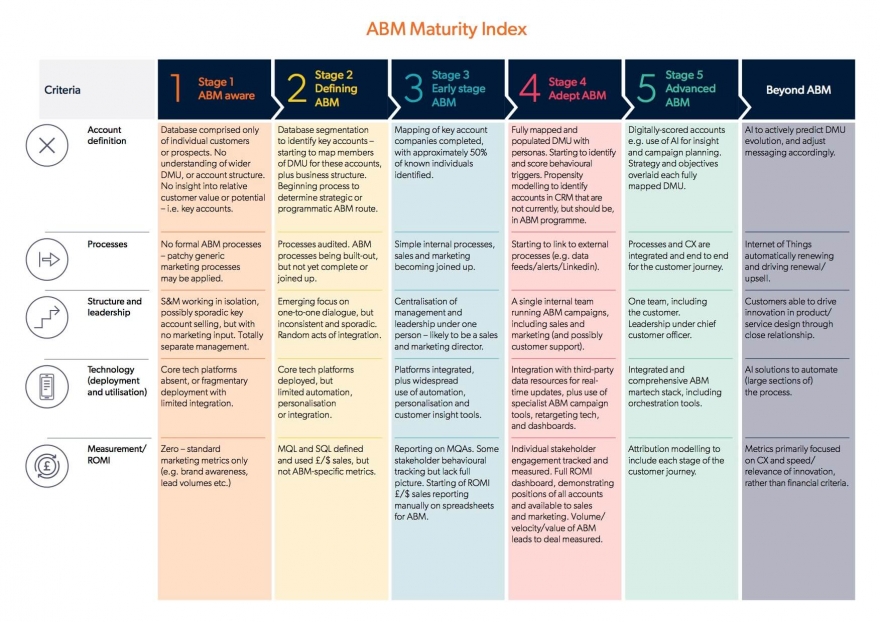Accenture’s adept account-based marketing
With Rhiannon Blackwell, Head of Account Based Marketing at Accenture UK
Accenture’s ABM programme has improved win rates by up to 18%. Rhiannon Blackwell, Accenture’s ABM lead talks about its success and the road to get there.

You can’t fail to be impressed when you hear Accenture speak publicly about its ABM programme.
It’s the same when you listen to the enthusiasm and advice of Rhiannon Blackwell, ABM lead at Accenture UK.
We’re diving deeper into the mechanics of the programme to understand why Accenture has been so successful.
ABM maturity
The ABM programme at Accenture has been running formally for three years, having previously been carried out ad hoc.
The company is comfortably sat in stage 4 of the B2B Marketing ABM Competency Model: Adept ABM.
This means it has fully mapped decision-making units and outlined personas. As well as this it’s tracking and measuring internal stakeholder engagement. It’s also linking external processes while operating from a dedicated internal ABM team.
Accenture is currently working on getting to stage 5: Advanced ABM, which means tightening processes that have already been started in stage 4, such as integration and account behaviour scoring.

The team and the accounts
Accenture UK has an ABM team of eight marketers who deliver strategic one-to-one ABM to 20 accounts across five industry groups: communications and technology, financial services, retail and consumer goods, oil and gas and the public sector.
Technology
As Accenture’s ABM programme focuses on one-to-one it’s quite tech light.
However, one-to-one relies on heavy collaboration which means its CRM is used religiously to measure stakeholder engagement, campaign performance, and ROI. The company also uses a marketing automation platform to help personalise customer journeys.
The pilot stage
Accenture knew its ABM programme would need to sit at the heart of the company because it needed to collaborate with a long list of teams such as digital marketing, sales, and competitor intelligence.
This meant getting buy-in was imperative for the success of the strategy. And while some stakeholders were easy to convince by telling them, others needed showing.
Accenture decided to run a pilot programme to demonstrate what ABM could do, so it looked for a promising account that could provide a success story.
“We chose an account that had really clear business objectives and had stakeholders we knew would give us the time and investment we needed from them,” explains Rhiannon.
Once the account had seen success, the ABM team packaged it up as a case study and promoted the story and the data internally.
The programme then began to sell itself. Now time has gone by, Rhiannon says she has to pitch ABM internally less frequently. “It’s often by word-of-mouth. Our client account leads are actually selling it to each other and are approaching us,” Rhiannon says.
For her, the challenge is keeping the initial enthusiasm from account leads waning. “It’s keeping the momentum going after you’ve sold it into an account,” she admits.
Internal personas
Although there sometimes is a stereotype attached to certain teams, the people within them are often very different to the way they react to change.
The ABM team recognised this and as part of their aim to gain buy-in and nurture enthusiasm, they outlined the personas of stakeholders they needed to get on their side, and created necessary solutions to suit them.
“Whatever job you do you’re going to run into these types of people,” says Rhiannon. “You have to be able to understand how different people work and communicate, so you can better work with them and get the outcomes you both want.”
Accenture came up with four main personas:
1. Debbie Downer
This persona will be the person in the meeting that is always negative about everything you present. That negativity can often be difficult to turn around, and it may take a while to encourage them to muster support.
Rhiannon says they encountered a ‘Debbie’ when trying to push account leads to become more active social sellers.
Often social can be quite difficult to sell, particularly when dealing with professionals who have had a career and seen success before the days of social media.
“In professional services it’s particularly critical because we’re in the business of selling people. It’s a shop window we can’t ignore,” she explains.
Advocacy and competition
To tackle Debbie, Rhiannon and the team first highlighted the key accounts who were active online. Second, they recruited other sales people who were more agreeable to the plan and gave them tips for updating their profile.
These employees then became advocates who could also chip away at Debbie.
The ABM team tried to make it as easy as possible for Debbie to become active on social. “We built a LinkedIn profile builder, and use LinkedIn Elevate which makes sharing content really simple,” says Rhiannon.
They further launched a social leaderboard because they knew sales responded well in a competitive environment. Debbie was at the top of the leaderboard because the ABM team had done most of the social for them. This was an ego boost, and won Debbie over.
“Finally, once the account lead was able to see what we were delivering through social, we started to go that one step further and suggest a paid social campaign to a very small targeted group of clients,” says Rhiannon.
2. Busy Ben
This persona really wants to do ABM but is so busy running around doing everything else on their list that they haven’t given ABM a look in. You’ve got the buy-in from the persona, but you haven’t got their time – therefore you need to make it as easy as possible, especially when it comes to tailoring content.
Rhiannon says Busy Ben is a common character in any workplace, so the ABM team looked for a way to help stakeholders customise content without spending a long time doing it.
Customisable content templates
The team created cross-account campaign assets which Ben can take off the shelf and quickly tailor accordingly rather than starting from scratch. This also allows the ABM team to present a quick win and keep momentum moving.
“When we have the first conversation [with the account lead] we have five options of things we can start next week while we delve into understanding the outcomes the client wants to drive and the outcomes we want to drive,” Rhiannon explains.
A great example of the power of repurposing is Accenture’s annual Technology Vision report which lists the five tech trends the business believes will shape companies.
“We knew it was a great piece of content but we needed to hand pick the pieces that were relevant to our clients,” says Rhiannon.
“We worked with technology experts on each of our teams to handpick trends and write about why they were relevant and what they mean for each of our clients. We had amazing results, our open rate was about 55%.”
Furthermore, the ABM has cut down thinking time for account leads by creating an ABM tool kit, which recommends tactics and channels based on the challenges the account is facing.
3. Kenny Keano
This persona loves ABM and wants to dive in head first. However while they may want everything you have to offer right now they most likely do not have the resources, budget and understanding fully in place.
Rhiannon says Kenny is the easiest persona to work with, however it’s still vital to manage their expectations.
Stakeholder profiling
To target Kenny’s ambitions of a giant leap into ABM, Accenture works with them to get the baby steps nailed firmly down. This essentially means extensive stakeholder profiling to ensure the programme will be delivering what it needs to.
“The first thing we do with these guys is always take a step back, we start with a workshop with the leadership team,” explains Rhiannon.
This session identifies four things:
- What the business outcomes are
- What the client wants to achieve
- Who the key players are
- What Accenture’s core messages for this account should be.
The ABM team then take the insight from the workshop and combine it with other search tactics. “We comb the internet to find relevant insights about clients using social media, news sources, company websites, and our own CRM,” says Rhiannon.
Accenture also use Crystal Knows, an online personality profiling tool. From here the ABM team design a bespoke campaign for communication.
However, Kenny is not happy to sit waiting for this carefully tailored campaign to arrive, and the ABM team want to capture their willingness.
“We don’t want enthusiasm to wane so we have some quick wins in our back pocket that we can roll out pretty quickly to immediately show the value that the ABM team are going to deliver to the account,” explains Rhiannon.
4. Olivia over-analyser
Nothing is left unscrutinised when it comes to this persona. Olivia wants all the data and needs time to analyse it before she gives the green light to anything.
This can make it difficult to get anything in an ABM programme going, especially if you’re trying to also manage Kenny who is raring to go.
Rhiannon describes this person as her nemesis, purely because she’s the opposite personality type
Ownership and control of the account
The ABM team understood Olivia feels protective of her accounts, and they knew they needed to work in a way that would suit this.
Convincing Olivia to work on the ABM team’s terms wasn’t an option if they wanted to get anything off the ground.
“They weren’t even comfortable doing the Technology Vision campaign because with that level of customisation they were worried it wasn’t 100% relevant to that particular account,” Rhiannon explains.
To tackle this, the ABM team gave Olivia control of the customisable content and access to working with subject matter experts. From here, they created a bespoke blog series, specifically tailored to the challenges Olivia’s account was facing.
After the account saw success, Olivia’s trust in the ABM team’s abilities to understand their accounts grew, and they became open to try more things in the ABM programme. It appears tactful perseverance is key here.
Success at Accenture
Accenture’s ABM has seen great success which has helped in expanding the programme further. At the B2B Marketing conference managing director, marketing and communications at Accenture, Sarah Thomas said the ABM programme had positively impacted on win rates of accounts by 15-18%.
An example of this success was a programme Accenture conducted to position itself as a preferred supplier of a major bank.
Sales and marketing teams closely collaborated to design an agile campaign which enabled account leads to respond to client needs as they developed. Ultimately these actions saw an engagement of 80% of the key decision-makers and met the objective in securing Accenture’s position.
The future for Accenture’s ABM
The goal that lays ahead for Accenture’s ABM programme is developing to maturity stage 5 advanced ABM. As part of this the company wants to be able to scale its ABM programme so it’s more able to serve on a global level.
For Rhiannon, the challenge will be to remain relevant and gain the same amount of knowledge on each account across a broader base.
“We’ve done quite a few things to address this challenge like introducing standardised processes across all our programmes, so we’re not re-inventing the wheel,” she says.
Rhiannon’s two top tips for ABM success:
- Start small; you don’t have to boil the ocean at the very start. Choose an account that has a clear and defined business objective you want to achieve. Deliver the pilot and get that amazing data and anecdote that will tell the story for you.
- Don’t create everything from scratch. You’re probably surrounded by marketers creating great content. Reuse and repurpose what’s out there but add a client lens. Then and only then, look to fill the gaps and bespoke activity.
